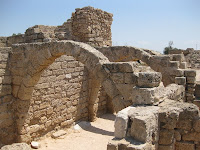May 5th
 After breakfast, we drove up to the northwest side of the Sea of Galilee. Our first stop was Tabgha. (Yes, I did misspell that name in yesterday’s message.) The church there commemorates the Multiplication of the Loaves and the Fishes, which is thought to have taken place near that spot. After touring the church, we went outside for Mass, at an area called Dalmanutha. The outdoor chapel there was being used, so the sister led us to a sort of campfire circle. Tim and Daryold decided that I should be the celebrant today (perhaps because the setting was so much like the Masses I used to have on hiking trips and canoe trips with Columbus Boys’ Camp). We used the special Mass texts (prayers and readings) for the Tabgha shrine. I found the experience to be quite moving, especially when breaking the bread during the “Lamb of God.”
After breakfast, we drove up to the northwest side of the Sea of Galilee. Our first stop was Tabgha. (Yes, I did misspell that name in yesterday’s message.) The church there commemorates the Multiplication of the Loaves and the Fishes, which is thought to have taken place near that spot. After touring the church, we went outside for Mass, at an area called Dalmanutha. The outdoor chapel there was being used, so the sister led us to a sort of campfire circle. Tim and Daryold decided that I should be the celebrant today (perhaps because the setting was so much like the Masses I used to have on hiking trips and canoe trips with Columbus Boys’ Camp). We used the special Mass texts (prayers and readings) for the Tabgha shrine. I found the experience to be quite moving, especially when breaking the bread during the “Lamb of God.”We then headed down the road to the Church of the Primacy of Peter, honouring the story in John 21 of the appearance of the Risen Lord to the disciples by the Sea of Galilee. There is a large outcropping of rock right in front of the altar. The rock is called the “Mensa Christi” -- “Table of Christ.” It is believed that this was the site where Jesus had prepared a meal for the disciples, then asked Peter to add a few of the fish that they had just caught. After that meal, Jesus asked Peter “Do you love me?” three times. After each positive response by Peter, Jesus commissioned him to “Feed my lambs/sheep.” (Peter is the only person to receive such a commission in the gospels.)
We then headed down the road to the ruins of Capernaum. The archaeologists have been able to identify one set of ruins as having probably been Peter’s house. A church has recently been built over the site. Nearby are the remains of a 4th Century synagogue. While it would not, of course, be the synagogue where Jesus taught and healed, the fact that ancient peoples tended to practice a form of “Reduce, Reuse, Recycle” when it comes to new buildings (i.e., building the new structure on the site of the previous structure) would seem to point to that synagogue as having been built on the site of the synagogue where Jesus did indeed teach and heal.
 After Capernaum, we continued clockwise around the Sea of Galilee (which is actually a freshwater lake), stopping at the Jordan River (near where it flows into the lake), an outlook on the eastern shore of the lake, and the Ein Gev kibbutz (on the eastern shore) for lunch. When we got to the southern end of the lake, we re-crossed the Jordan River and headed straight south. We stopped near the old Crusader fortress of Belvoir in order to look out over the Gilead Mountains to the east and Mt. Tabor (traditional site of the Transfiguration) to the west. We then stopped at Beit Alfa, site of the ruins of the ruins of a 6th Century synagogue which had a beautiful mosaic floor. We then headed back to Nazareth, where we took a complete tour of the Basilica of the Annunciation.
After Capernaum, we continued clockwise around the Sea of Galilee (which is actually a freshwater lake), stopping at the Jordan River (near where it flows into the lake), an outlook on the eastern shore of the lake, and the Ein Gev kibbutz (on the eastern shore) for lunch. When we got to the southern end of the lake, we re-crossed the Jordan River and headed straight south. We stopped near the old Crusader fortress of Belvoir in order to look out over the Gilead Mountains to the east and Mt. Tabor (traditional site of the Transfiguration) to the west. We then stopped at Beit Alfa, site of the ruins of the ruins of a 6th Century synagogue which had a beautiful mosaic floor. We then headed back to Nazareth, where we took a complete tour of the Basilica of the Annunciation.We’ve gotten tired of the Middle Eastern version of “salad” (about 17 little bowls of various pre-dinner foods, only one or two of which resemble what North Americans call salad), so we had dinner here at the Nazareth Sisters convent. The Nazareth Sisters originated in France, so it was a very simple French-style “souper” (supper), staring with soup, continuing with chicken, peas, and potatoes, followed by salad (i.e., lettuce and cabbage with a vinaigrette), and ending with fresh fruit.
Almost home now, ready to take off. See you all very soon!
- William



1 comment:
I appreciate the labour you have put in developing this blog. Nice and informative.
Post a Comment